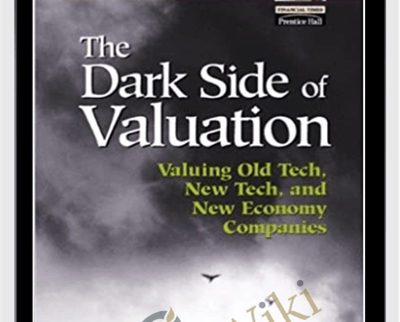The Dark Side Of Valuation Valuing Old Tech, New Tech, And New Economy Companies – Aswath Damodaran
Original price was: $46.99.$13.00Current price is: $13.00.
The Dark Side Of Valuation Valuing Old Tech, New Tech, And New Economy Companies – Aswath Damodaran Download. The book is structured around the valuations …
Salepage link: At HERE. Archive:
(Pearson Education) A comprehensive guide to valuing technology companies, for investors, financial executives, venture capitalist, and other professionals. Includes 5 detailed case studies that cover the entire tech lifecycle, from Amazon.com to Cisco and Motorola. DLC: Valuation.
Amazon.com Review
If the tech-stock swoon merely whets your appetite for this roller coaster of a market sector, and your eyes don’t glaze over at the very sight of formulas like “Return on Capital = EBIT (1 – t) / Capital Invested,” then The Dark Side of Valuation is the investment guide you’ve been waiting for. Whether considering New Economy firms at their peak or their valley, writes Aswath Damodaran, the problem has always been determining their true value with equitable dispassion. A leading expert on the topic, Damodaran begins by noting that standard corporate valuations are determined by four factors: cash flow from existing investments, growth expected from this cash flow, length of time this growth is sustained, and cost of capital to sustain it. In what he admits is not always an easy read, Damodaran then details various ways to adapt conventional valuation methods for companies that lack key traditional variables (such as profits, track records, and even competitors with which they can be compared) in order to arrive at realistic valuations. Those not scared off by charts comparing the historical risk for T-bills and T-bonds since 1928 will find this book worth a look. –Howard Rothman
From the Inside Flap
Preface
Do the old rules still apply? Do we need new valuation metrics, or are the old metrics flexible enough to deal with the companies that constitute the new economy? Can you value a company that has no earnings, no history, and no comparable firms? These are the questions that I have heard repeatedly over the last few years. I have always believed the fundamentals that determine value are the same, no matter what company you value and what market it is in. Increasingly, though, I have faced skeptical audiences who are unwilling to take this belief at face value and have demanded proof that America Online, Amazon, or Priceline can be valued with traditional models.
The genesis for this book was a paper I did on valuing Amazon in March 2000, where a discounted cash flow model yielded a value of $34 per share. Since the stock was trading at $80 at that time, there were many who viewed the valuation as either excessively pessimistic or as missing something. The interest in the paper led me to think about writing a book, but I expanded it to cover both new technology and old technology firms. While there are differences in estimation that arise across these firms, I believe that they have far more in common. Why technology firms? I believe that traditional valuation books and models (and I count my book on investment valuation among the culprits) have tended to concentrate on valuing manufacturing or traditional service firms. Technology firms are different. They expand by investing in research and through acquisitions and not by building plant and equipment. Many of them have astronomical growth rates in revenues and often, very little in current earnings. Their assets are often patents, technology, and skilled employees. I look at how the notions of capital expenditures, operating income, and working capital have to be redefined for these firms.
I begin this book by laying out the facts on the growth of technology and, in particular, new technology stocks in the equity market and argue that although the principles of valuation might not shift, the focus can change as firms move through their life cycles. This discussion is followed by an extended section (Chapters 2-7) on applying traditional discounted cash flow models to value technology stocks, with an emphasis on the estimation of cash flows, growth, and discount rates for these firms. In the next three chapters, I look at the use of relative valuation to value technology companies, both in terms of adapting existing multiples (such as price-earnings and price-to-sales ratios) and developing new ones (value per Web site visitor, for instance). In Chapter 11, “Real Options in Valuation,” I consider an argument made by many for the large premiums paid on technology stocks (i.e., they represent real options to expand into a potentially huge e-commerce market), and consider some questions that a skeptic should ask before accepting this argument. In Chapter 12, “Value Enhancement,” I consider how managers of technology firms can enhance the value of their firms through better investment and financing decisions.
The book is structured around the valuations of five technology firms-Motorola, Cisco, Amazon, Ariba, and Rediff. The first three are household names but represent three different points in the technology spectrum. Motorola is an old technology firm with substantial investments in existing assets. It is also a firm that has fallen on hard times in the last few years, largely as a consequence of poor investments and strategic choices. Cisco is one of the great success stories of the 1990s, but a great deal of the market value of the firm reflects expectations about the future. It is also a firm that has chosen to grow through acquisitions and has done it very well. Amazon is the poster child (for better or worse) for the new economy stocks that have entered the market in recent years, and the popular press has documented its ups and downs in extensive detail. Ariba and Rediff are more recent entrants into the new economy, with Ariba representing the promise (and peril) of the Business-to-Business (B2B) Internet model, and Rediff the potential of an Internet portal serving a market (India) that could be a huge market in the future.
One of the limitations of valuing real companies is that your mistakes are there on the printed page for all to see over time, but that prospect does not bother me. At the risk of giving away the punch line, I do find discounted cash flow values for all five companies: Motorola ($32.39), Cisco ($44.92), Amazon ($34.37), Ariba ($72.13), and Rediff ($19.05). For what it is worth, at the time that I did the valuations in June 2000, I found Amazon to be overvalued at $48 per share and Cisco to be overvalued at $64.88. Motorola at $34.25 per share and Ariba at $75 per share were fairly valued, and Rediff was significantly undervalued at $10 per share. By the time I finished the book, Amazon had dropped in value to $30 per share, and Cisco was trading at $51. Motorola had gone from being fairly valued to undervalued, Ariba saw its stock price double, and Rediff remained undervalued. I have no doubt that you will disagree with me on some of the inputs I have used, and the values that you assign these firms will be different from mine. What I would emphasize, therefore, is not the values that I arrive at for these firms, but the process by which I got there.
Finally, I want this book to be useful to a wide audience: individual investors who hold technology stocks in their portfolios, equity research analysts, venture capitalists, and managers at technology firms. There are portions of the book that I must confess are not easy reading, but I have tried as much as I can to provide an intuitive rationale for everything that I do. Technology firms, notwithstanding the back and forth of markets, are here to stay, and valuing them is something we all need to grapple with. I hope you find this book useful in that endeavor.
From the Back Cover
- The comprehensive guide to valuing technology companies
- Projections for future revenues, earnings, cash flows, the impact of stock options, and more
- 5 detailed case studies cover the entire tech lifecycle: Amazon.com, Ariba, Cisco, Motorola, and a new IPO
- Presented by one of the world’s leading experts in valuation
- State-of-the-art tools for assessing the value of any technology company
Technology companies have exploded in importance, yet investors and analysts face unprecedented challenges in valuing them. In The Dark Side of Valuation, one of the world’s leading valuation experts reviews every approach, demonstrating exactly how to adapt traditional techniques to minimize risks and maximize returns.
Aswath Damodaran begins with an overview of the markets’ dramatic shift towards technology stocks ? specifically new technology stocks. He then identifies key valuation principles and techniques, demonstrating them through five case studies that encompass the entire technology company lifecycle: Amazon.com, Ariba, Cisco, Motorola, and a new IPO-ready startup. Coverage includes:
- Adaptation of discounted cash flow models for tech companies with limited histories, shifting business mixes, and volatile stock prices
- The limitations of traditional accounting definitions in measuring technology company cash flows
- Superior processes for estimating future revenues, earnings, and cash flows
- Evaluation of the impact of management and employee stock options on share value and earnings multiples
- An in-depth assessment of PEG and price-to sale ratios
- Relative valuation: fundamentals, earnings multiples, and revenue multiples
“What a refreshing book to read! Damodaran’s book is essential if capital markets are going to accurately gauge the contributions of emerging companies…His insights are illuminating and his mastery of financial analysis is unmatched.”
Here's an overview of the prominent keywords and a list of famous authors:
Business and Sales: Explore business strategies, sales skills, entrepreneurship, and brand-building from authors like Joe Wicks, Jillian Michaels, and Tony Horton.
Sports and Fitness: Enhance athleticism, improve health and fitness with guidance from experts like Shaun T, Kayla Itsines, and Yoga with Adriene.
Personal Development: Develop communication skills, time management, creative thinking, and enhance self-awareness from authors like Gretchen Rubin, Simon Sinek, and Marie Kondo.
Technology and Coding: Learn about artificial intelligence, data analytics, programming, and blockchain technology from thought leaders like Neil deGrasse Tyson, Amy Cuddy, and Malcolm Gladwell.
Lifestyle and Wellness: Discover courses on holistic health, yoga, and healthy living from authors like Elizabeth Gilbert, Bill Nye, and Tracy Anderson.
Art and Creativity: Explore the world of art, creativity, and painting with guidance from renowned artists like Bob Ross and others.
All the courses on WSOlib are led by top authors and experts in their respective fields. Rest assured that the knowledge and skills you acquire are reliable and highly applicable.
Specification: The Dark Side Of Valuation Valuing Old Tech, New Tech, And New Economy Companies – Aswath Damodaran
|
User Reviews
Only logged in customers who have purchased this product may leave a review.

Original price was: $46.99.$13.00Current price is: $13.00.












There are no reviews yet.